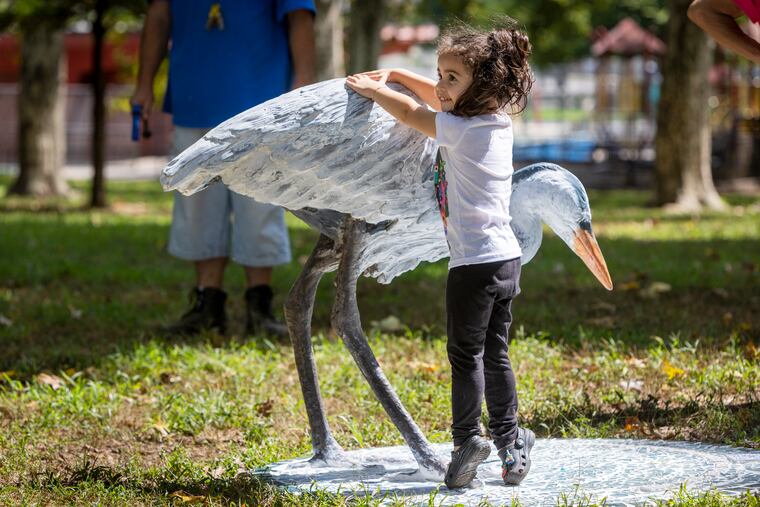Once neglected and ignored, Tacony Creek Park is finally getting visitors thanks to Tookany/Tacony-Frankford Watershed Partnership programs
TTF uses programming to build interest in, and advocacy for, Tacony Creek Park. And the organization is set to reveal its master plan for enhancing the watershed’s future.

Over Memorial Day weekend, the Tookany/Tacony-Frankford Watershed Partnership (TTF) hosted the first of its 2023 Revival Walks series with Mama Carla Wiley in partnership with the Olney Culture Lab.
June 3 will be the return of the family-friendly River Alive! Learning Trail in Juniata Park. The trail is made up of six benches and animal sculptures designed to draw youngsters’ attention to the Tacony Creek.
Then there is TTF’s thrice weekly Walk With Me program, which is especially good for those who don’t want to stroll alone.
So what do any of these programs have to do with a watershed?
“We do programming because that is how you connect to people” about the watershed, said Julie Slavet, TTF’s executive director since 2011.
We all live in a watershed
Everyone lives in a watershed, which is the land that channels rainfall and snowmelt to a stream, lake, river, and eventually the ocean. The Tookany /Tacony Frankford watershed covers 30 square miles and starts in Montgomery County, where it’s called the Tookany Creek.
As it moves into city neighborhoods such as Olney and Hunting Park, the name changes to Tacony Creek. Eventually, the creek meets up with Wingohocking Creek to become Frankford Creek.
For the Philadelphia Water Department, TTF’s founder and one of its major funders, the organization is part of a water quality management strategy that centers on community involvement.
“I always ask people at those events what they want to see [in the park]. People are always looking for things their kids can do. In our neighborhoods, they have limited resources, and going to a museum is expensive, and schlepping into the city is expensive,” Slavet said.
Increasing community members’ stewardship will help limit the pollutants the creek picks up as it flows into the Delaware River, the source of drinking water for half of Philadelphia.
But for those in the Philadelphia portion of the Tookany/Tacony-Frankford watershed, cleanup is a huge lift because it’s also the place where all the sewers flow to a single end point, known as a sewershed.
“This is a creek that is sort of a sacrifice creek,” Slavet said.
“We want it for recreation and enjoyment, but our watershed is the biggest sewershed in the [city’s] system. It has a lot of combined sewage that goes into it. An average of once a week a year, raw sewage goes into the Tacony Creek.”
Slavet added that people had to wait 24 hours after heavy rains to use the park again because of the sewage overflow.
‘People didn’t know about the park at all’
The sewage in the creek and the neglect of the park shocked Slavet when she first joined TTF.
“I was really appalled. I couldn’t believe how neglected it was. There was a lot of trash, it was overgrown, and I don’t think we saw any other people,” she said. As she talked to residents she realized that “people didn’t know about the park at all.”
Creeks became a hidden part of the city as early urban planners encased them in sewers to solve the water pollution problems created by thousands of residents, farmers, and businesses tossing raw sewage and wastewater into the local creek and its tributaries. The Tacony Creek is visible only in the park, which is one of the city’s five watershed parks, and the quality of the city’s drinking water is inextricably linked to the well-being of the park.
The cost of this invisibility was neglect.
The Philadelphia Water Department’s surveys of the TTF watershed 25 years ago found a similar problem. The use of all-terrain vehicles, cars, and motorcycles on park roads, eroded streambanks, abandonment of cars, and trash dumping were listed as major watershed issues resulting in a degraded aquatic habitat and concerns about public health and safety.
Now, after a decade of making such changes as adding signage, it’s time for a new master plan for Tacony Creek Park.
On June 7, from 5 to 7 p.m., TTF is unveiling the new park plan and the group’s intention to take on more responsibility, such as reversing the city’s refusal to put trash cans in the park.
“We are trying to develop an agreement with the city that we will service the trash cans. We will take that responsibility. Right now, it doesn’t happen,” Slavet said